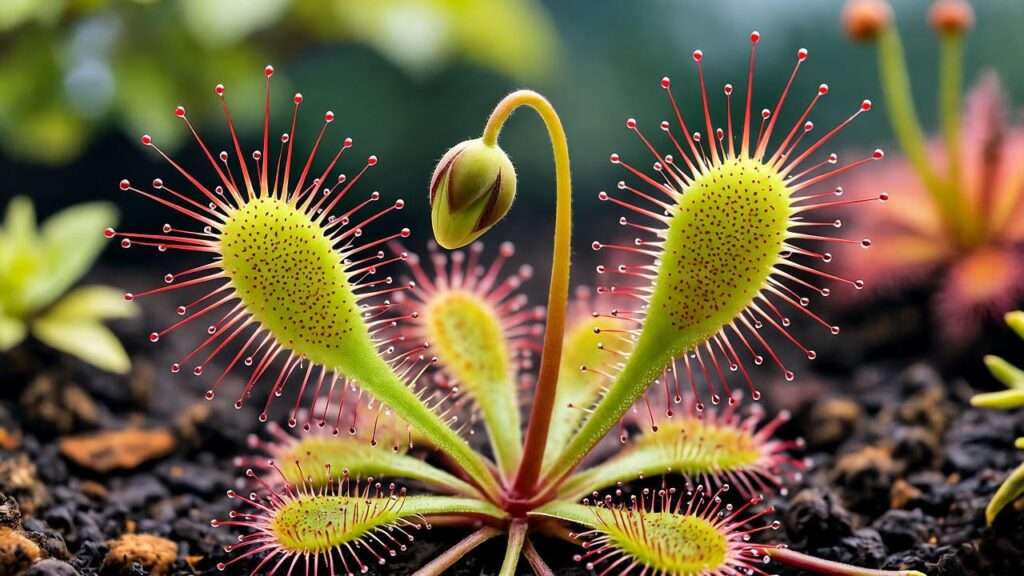Imagine a plant that sparkles like a jewel, lures insects with its glistening dew, and thrives with just a little know-how—meet the sundew, a carnivorous marvel that’s stealing the hearts of plant lovers everywhere! Whether you’re a beginner or a seasoned grower, mastering sundew plant care is the key to keeping these fascinating plants vibrant and healthy. In this comprehensive guide, we’ll dive into everything you need to know to grow thriving sundews, from light and water to feeding and propagation. Backed by years of hands-on experience and botanical expertise, this article will equip you with practical, actionable tips to ensure your sundew flourishes. Ready to unlock the secrets of these captivating carnivores? Let’s get started! 🌞
What Are Sundew Plants? 🪴
Overview of Sundew Plants
Sundews, belonging to the Drosera genus, are carnivorous plants known for their sticky, glistening leaves that trap insects with a sweet, mucilage-like dew. With over 200 species, sundews are found worldwide, from tropical jungles to temperate bogs. Popular varieties like Drosera capensis (Cape sundew) and Drosera spatulata (spoon-leaved sundew) are prized for their compact size and striking appearance. Each leaf is covered in tiny, hair-like tentacles that secrete a sticky substance, making sundews both beautiful and functional as natural pest controllers. Fun fact: Sundews have evolved over millions of years to thrive in nutrient-poor soils by digesting insects for essential nutrients like nitrogen! 🐞
Why Grow Sundews?
Sundews are a plant enthusiast’s dream—low-maintenance, visually stunning, and perfect for small spaces like windowsills or terrariums. They offer eco-friendly pest control by naturally reducing flies and gnats in your home. Their interactive nature, as they slowly curl around captured prey, fascinates both kids and adults, making them a conversation starter. Whether you’re drawn to their unique biology or want an easy-care plant with personality, sundews deliver. Plus, their compact size and minimal soil needs make them ideal for urban gardeners or anyone looking to add a touch of the extraordinary to their collection. 🌼
Essential Sundew Plant Care Requirements 🌞
Light Needs ☀️
Light is the lifeblood of sundew plants. Most species thrive in bright, indirect light or full sun, requiring 12–16 hours of light daily to produce their signature sticky dew. Place your sundew near a south-facing window or under full-spectrum grow lights (15–20 watts, positioned 6–12 inches above the plant) for indoor setups. Insufficient light leads to weak, elongated growth and reduced mucilage production. For example, Drosera capensis will lose its vibrant red hue in low-light conditions. A common mistake is assuming ambient room light is enough—sundews demand intense light to mimic their natural bog habitats. Pro tip: Rotate your plant every few days to ensure even light exposure! 🌞
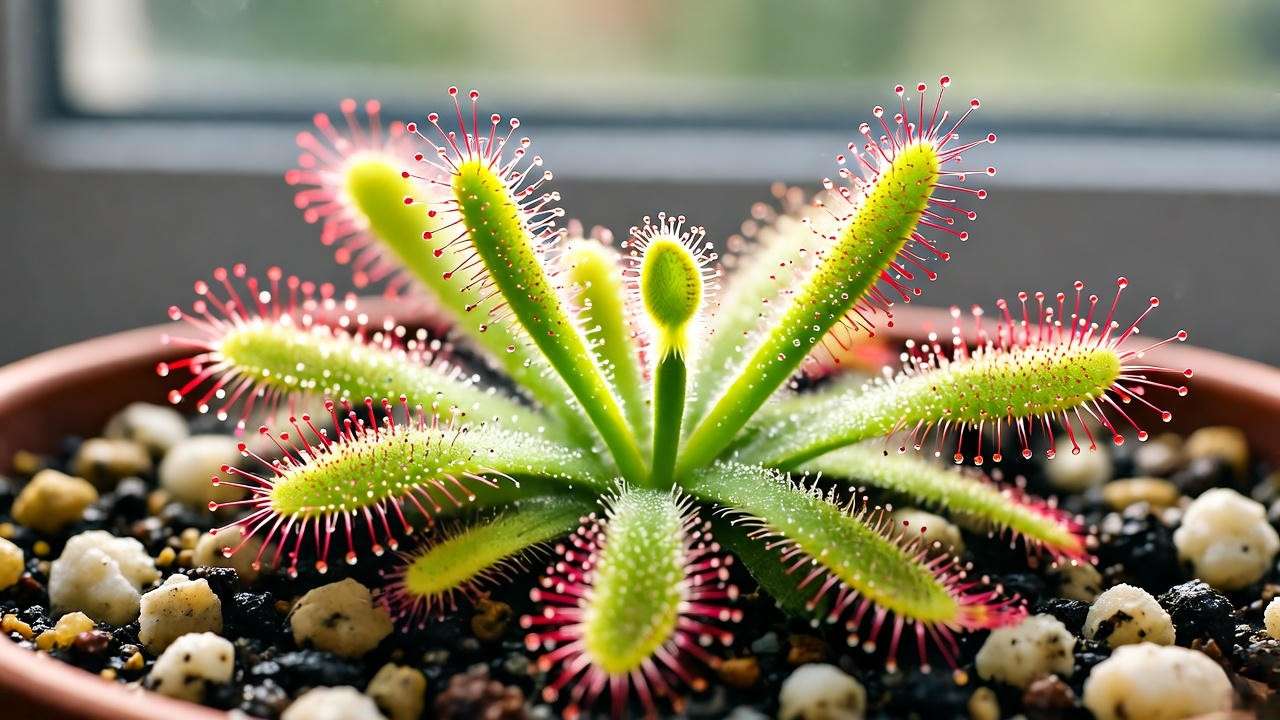
Watering and Humidity 💧
Sundews love consistently moist soil but are sensitive to water quality. Always use distilled water, rainwater, or reverse-osmosis water to avoid mineral buildup, which can harm their delicate roots. The tray watering method is ideal: Place the pot in a shallow tray filled with 1–2 inches of water, allowing the soil to stay evenly moist. Top watering can work but risks dislodging dew or compacting soil. Aim for 50–80% humidity, which you can achieve with a humidity tray, terrarium, or humidifier for indoor plants. Low humidity causes leaves to dry out, reducing stickiness. Expert tip: Check the tray daily to ensure it never dries out, especially in hot weather! 💦
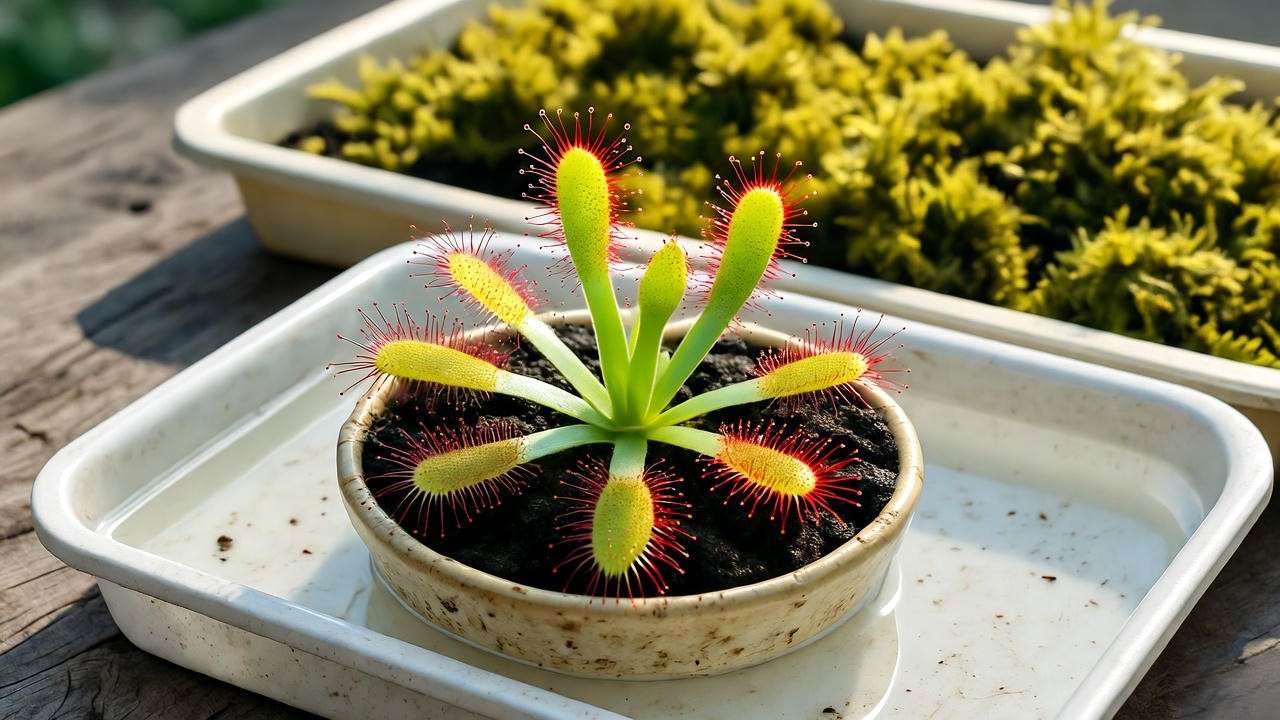
Soil and Potting Mix 🪣
Sundews require a specific soil mix to thrive: a 1:1 ratio of peat moss and perlite or silica sand. This blend ensures proper drainage and the acidic, nutrient-poor conditions sundews love. Never use regular potting soil or compost, as these contain minerals and fertilizers that can burn sundew roots. Choose shallow, wide pots (4–6 inches deep) with drainage holes to prevent waterlogging. For example, a 5-inch plastic pot works well for Drosera spatulata. Repot every 1–2 years to refresh the soil and prevent compaction. Pro tip: Pre-soak the soil mix before planting to ensure even moisture distribution. 🌱
Feeding Your Sundew 🐞
Sundews are self-sufficient hunters, using their sticky leaves to capture small insects like gnats or fruit flies. In outdoor or greenhouse settings, they typically catch enough prey naturally. Indoors, you may need to supplement with occasional feedings. Use small, live insects or rehydrated dried insects (like bloodworms) every 1–2 weeks. To feed, gently place the insect on a sticky leaf and let the plant do the rest—avoid forcing leaves to close. Never use fertilizer, as it can overwhelm the plant’s sensitive system. Overfeeding is a common mistake; one or two insects per month is plenty for most sundews. Example: Drop a single fruit fly on a Drosera capensis leaf and watch it curl over 1–2 hours—mesmerizing! 🕸️
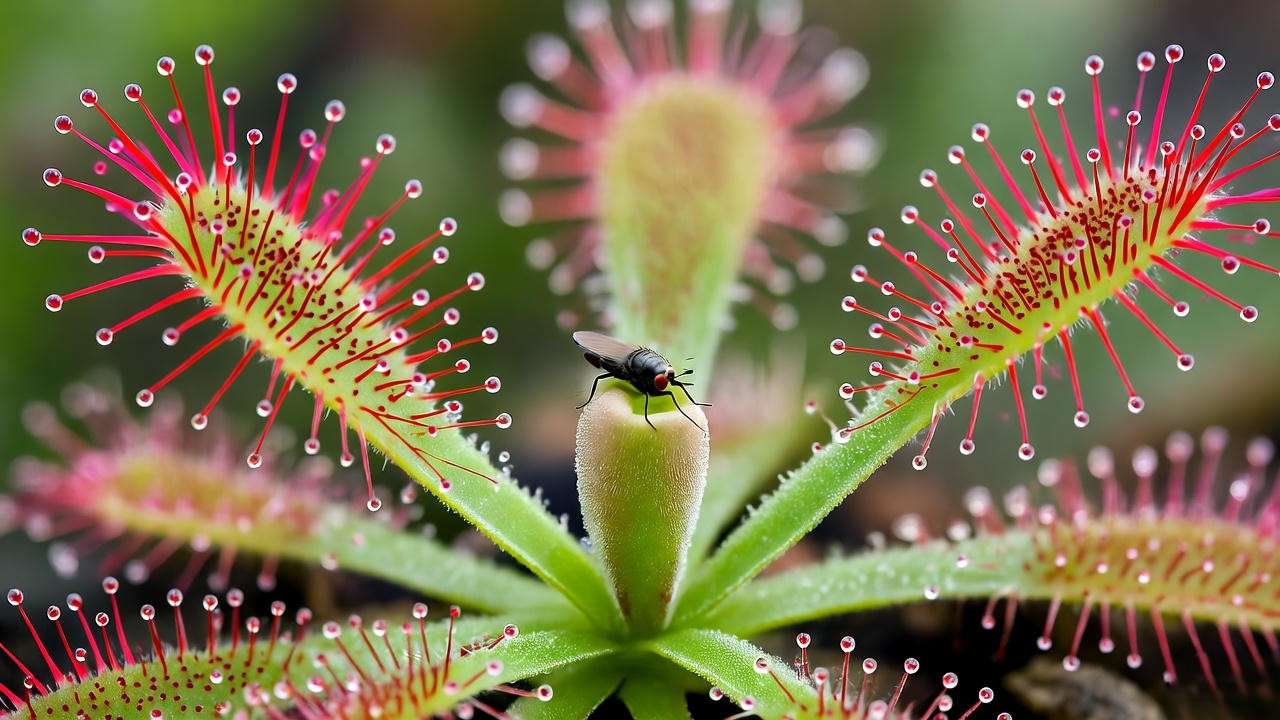
Temperature and Seasonal Care ❄️🌸
Ideal Temperature Range
Most sundews thrive in temperatures between 60–85°F (15–29°C), making them adaptable to typical indoor environments. Tropical species like Drosera capensis prefer consistent warmth, while temperate species like Drosera binata may enter dormancy in winter. During dormancy, temperate sundews form a tight rosette and require cooler temperatures (40–50°F or 4–10°C). Keep tropical sundews away from cold drafts or sudden temperature drops. Use a thermometer to monitor conditions, especially in unheated spaces. Expert insight: A small space heater or heat mat can stabilize temperatures for indoor sundews during winter. 🌡️
Seasonal Adjustments
In summer, increase watering to maintain soil moisture in hotter, drier conditions. For temperate sundews, reduce watering during winter dormancy and store them in a cool, bright location like an unheated garage. Tropical sundews need consistent care year-round but benefit from slightly higher humidity in dry winter months. Monitor light levels as seasons change, supplementing with grow lights if natural light decreases. For example, Drosera aliciae may slow growth in winter but rebounds with proper light and humidity. Pro tip: Use a hygrometer to track humidity and adjust as needed to mimic sundews’ natural bog environment. 🌦️
Common Sundew Plant Problems and Solutions 🩺
Yellowing or Drooping Leaves
Yellowing or drooping leaves often signal overwatering, insufficient light, or poor water quality. Check the soil: If it’s soggy, reduce watering and ensure proper drainage. If leaves are pale or stretched, increase light exposure to 12–16 hours daily. Always use mineral-free water to prevent chemical stress. For example, switching to distilled water resolved yellowing in my Drosera capensis within two weeks. Solution: Adjust care conditions and trim dead leaves with sterile scissors to encourage new growth. 🌿
Lack of Dew or Stickiness
If your sundew’s leaves lack their characteristic sticky dew, low humidity, tap water, or insufficient light are likely culprits. Boost humidity to 50–80% with a tray or terrarium, switch to distilled water, and ensure adequate light. For instance, Drosera spatulata regained its dew after I moved it under a grow light and added a humidity tray. Avoid touching leaves, as oils from your skin can reduce stickiness. Solution: Optimize environmental conditions and be patient—dew production often resumes within days. 💧
Pests and Diseases
While sundews are pest-resistant due to their carnivorous nature, aphids or fungal infections can occasionally strike. Aphids can be removed with a gentle spray of distilled water or treated with diluted neem oil (1:10 ratio). Fungal issues, like mold, arise from poor air circulation or overly wet conditions. Increase airflow with a small fan and reduce watering slightly. Prevention tip: Inspect plants weekly and keep the growing area clean to minimize risks. My own Drosera binata once had a minor mold issue, resolved by improving ventilation. 🪴
Propagating Sundews 🌱
Methods of Propagation
Sundews are easy to propagate, offering multiple methods for expanding your collection. Leaf cuttings are the most popular: Gently remove a healthy leaf, place it on damp sphagnum moss, and keep it in a humid, bright environment. Roots and plantlets form in 4–8 weeks. Seeds require patience—collect mature seeds, sow them on a peat-perlite mix, and maintain high humidity for germination (6–12 weeks). Division works for mature plants: During repotting, separate offsets and replant in fresh soil. Example: I propagated Drosera capensis via leaf cuttings, yielding three new plants in two months! 🌿
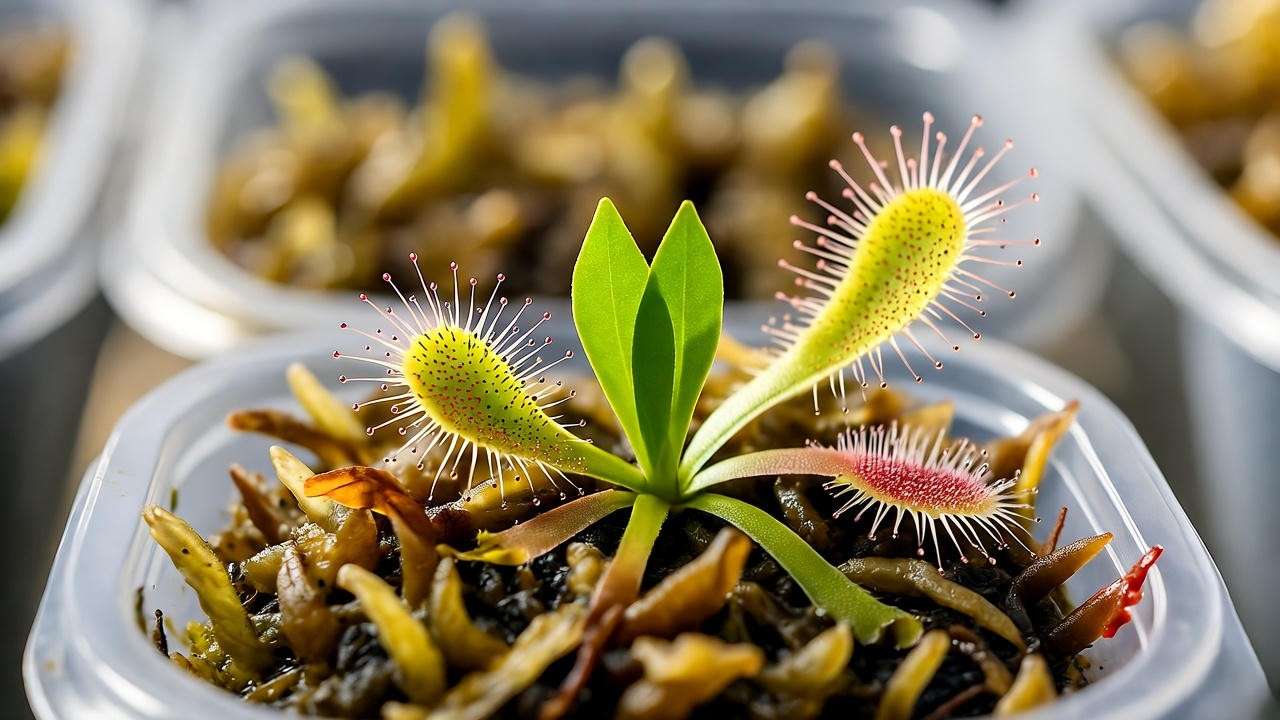
Best Practices for Success
Use sterile tools to prevent contamination and maintain high humidity (80%+) during propagation. Bright, indirect light encourages healthy growth without scorching delicate plantlets. Keep the soil consistently moist but not waterlogged. Patience is key—propagation can take time, but the reward is worth it. Expert tip: Cover propagation trays with clear plastic to trap humidity, checking weekly for growth. 🌱
Advanced Care Tips for Thriving Sundews 🌟
Creating a Mini Bog Environment
For a stunning display, create a mini bog by planting sundews in a wide, shallow tray with other carnivorous plants like Venus flytraps or pitcher plants. Use a 1:1 peat-perlite mix and keep the tray filled with 1–2 inches of distilled water. This setup mimics sundews’ natural wetland habitats, promoting vigorous growth. Add a layer of live sphagnum moss for aesthetic appeal and humidity. My own bog tray with Drosera spatulata and Sarracenia has thrived for years with minimal maintenance. 🌿
Companion Plants
Pair sundews with compatible carnivorous plants like Nepenthes (pitcher plants) or Dionaea muscipula (Venus flytraps) for a diverse display. Ensure companions share similar needs: acidic soil, high humidity, and mineral-free water. Avoid non-carnivorous plants, as they may introduce unwanted nutrients or pests. Pro tip: Group plants in a glass terrarium for a low-maintenance, high-impact setup. 🌼
Long-Term Maintenance
Repot sundews every 1–2 years to refresh soil and prevent root crowding. Trim dead leaves with sterile scissors to maintain appearance and prevent mold. Monitor for signs of nutrient deficiency, like slow growth, and supplement with occasional insect feedings. Example: Repotting my Drosera aliciae every 18 months keeps it vibrant and productive. 🌱
FAQs About Sundew Plant Care ❓
- Q1: Can sundews grow indoors without sunlight?
Answer: Yes, with full-spectrum grow lights providing 12–16 hours of light daily. Position lights 6–12 inches above the plant for best results. - Q2: How often should I feed my sundew?
Answer: Feed every 1–2 weeks if natural prey is scarce. One or two small insects per month is sufficient. - Q3: Why is my sundew not producing dew?
Answer: Check for low humidity, poor water quality, or insufficient light. Adjust conditions to restore dew production. - Q4: Are sundews safe for pets?
Answer: Sundews are non-toxic but keep them out of reach to prevent curious pets from damaging delicate leaves.
Conclusion 🌼
Caring for sundew plants is a rewarding journey that combines science, beauty, and a touch of magic. By providing bright light, mineral-free water, acidic soil, and occasional feedings, you can keep your sundew thriving for years. Whether you’re captivated by their insect-trapping prowess or their sparkling leaves, sundews are a low-maintenance, high-impact addition to any plant collection. Apply the tips in this guide, and you’ll be well on your way to mastering sundew plant care. Have questions or success stories? Share them in the comments or on social media—we’d love to hear from you! 🌟

